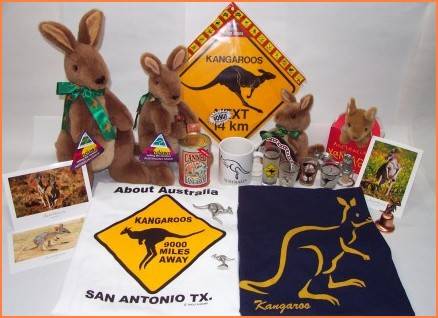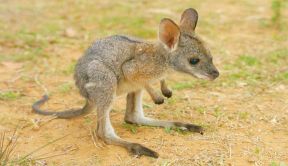
About Australia
Australian Foods, Gifts and Souvenirs
401 Isom Rd, Suite 500, San Antonio, Texas, 78216, USA
Phone 210-299-1077, Fax 210-541-6755
www.about-australia-shop.com
KANGAROOS

Photograph of select Kangaroo gifts & souvenirs
Buy Kangaroo gifts & souvenirs and other Australian Goods (Click Here)
PRODUCTS THAT WE CARRY
|
WHAT IS A KANGAROO?
| Kangaroos, or "roos" (a common abbreviation) are perhaps the most widely recognised Australian native animal. As a symbol of Australia, roos are constantly used by Australian businesses and organisations to display their patriotism and pride towards their homeland. |  |
 |
 |
There are many different breeds of Kangaroos, each native to their own area within Australia; but the three most abundant and distinct kinds are the Red Kangaroo, the Western Grey Kangaroo, and the Eastern Grey Kangaroo. Roos are marsupials, which means they are mammals which carry their young in a pouch on their abdomen for several months after birth. A young Kangaroo, called a Joey, has a rather short gestation period of one month (in comparison to a human's 9 months), after which it will constantly remain in it's mother's pouch for a further 8 months before it explores it's immediate surroundings and then eventually ceases to use the pouch at 10 months of age. Joeys will continue to nurse from their mothers for another 6 months, and until they aren't allowed to do so. Known for their hop, Roos are unable to walk because they cannot move each of their two hind legs independently. This is with the exception of the Tree Kangaroo only. Roos feed on a wide variety of grasses because they are herbivorous, and if enough green plants are available, do not need a regular source of water. |
RED KANGAROOS (Macropus rufus)
|
Red Kangaroos are named after their distinctively red
fur, a result of evolution, likening them to their native habitat of the
arid plains and bush land of the central Australian outback. Although the
males possess this feature, female Reds often have more of a blue/grey
colour to their fur and are sometimes to referred to as Blue-fliers. Reds
are the largest breed of Kangaroo, and also the biggest marsupial in
existence today, measuring an average of 5'11" (180cm) in height and
weighing around 200lb (90kg). Red Joeys become independent from their
mothers at a relatively young age due to their predatory environment and
need to learn quickly if they are going to avoid being the dinner of a
fox, eagle or dingo. Their superior long-range vision is essential to
their survival on the open plains, but Reds' have poor short-range sight.
|

EASTERN GREY KANGAROOS (Macropus giganteus)
|
Even though the Red Kangaroo is perhaps the best known
breed by reputation, it is the Eastern Grey that is more frequently and
readily seen by people. This is because Eastern Greys are found in the
forested, coastal areas of eastern and south-eastern Australia; much
closer to the majority of the population (of people) than is central
Australia, the home of Red Kangaroos. Sometimes referred to as the
Forester Kangaroo, the Eastern Grey actually prefers open grasslands for
grazing (at night) and bush land for shelter by day. Unfortunately, due to
occasional snowballing populations of Eastern Grey Roos (in particular
areas), shooters are sometimes employed to cull, and to thus avoid
widespread starvation of the Roos.
|
WESTERN GREY KANGAROOS (Macropus fuliginosus)
|
Eastern and Western Grey Kangaroos are two completely
separate species that both look and behave differently. Western Greys are
found on the opposite side of Australia, around the southern and western
coastal areas where human population is relatively scarce. They have soft
charcoal-brown fur, as opposed to Eastern Greys which are more of a
steel-grey colour. Western Greys are very intelligent and social
creatures, known to keep family ties for up to 3 generations and several
years. |
Buy Kangaroo gifts & souvenirs and other Australian Goods (Click Here)
Privacy Policy

About Australia
Australian Foods, Gifts and Souvenirs
401 Isom Rd, suite 500, San Antonio, Texas, 78216, USA
Phone 210-299-1077, Fax 210-541-6755
www.about-australia-shop.com